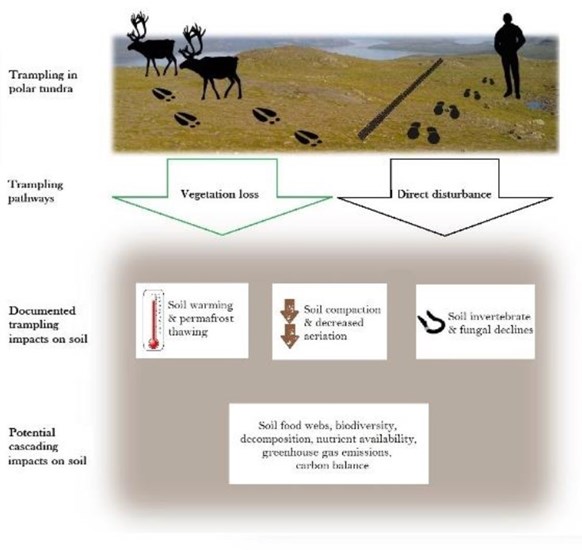We carried out a literature review 1) to map how trampling affects soils across ecosystems and 2) to gather empirical evidence about trampling effects on polar tundra soils.

The reviewed literature revealed deteriorating effects of trampling on vegetation and, in polar tundra, trampling was particularly harmful for mosses. Since mosses play an important role in insulating tundra soils, the trampling-induced thinning and loss of the moss layer often leads to increasing soil temperatures that can further induce thawing of permafrost. Together, soil warming and permafrost thawing can, in turn, increase greenhouse gas emissions from polar tundra soils.
Our review also showed that trampling often induces soil compaction. This links with decreased soil pore space and reduced availability of oxygen and both of these changes have the potential to cascade down to soil biota. In line with this, trampling decreased the abundance of soil invertebrates and fungi, whereas bacteria were more resistant to trampling-induced changes in the soil environment.
We conclude that even though some of the trampling-induced impacts on soils are well documented and have received empirical evidence even from the polar tundra, the cascading effects and pathways leading to altered ecosystem services, such as soil biodiversity, nutrient availability and carbon balance, remain largely undocumented. The tundra-specific patterns reported in the paper highlight the urgent need for more empirical work to support informed efforts to manage and predict the functioning of polar tundra under global changes.
You can find the full article here.
Reference: Tuomi, M., Väisänen, M., Ylänne, H., Brearley, F.Q., Barrio, I.C., Bråthen, K.A., Eischeid, I., Forbes, B.C., Jónsdóttir, I.S., Kolstad, A.L., Macek, P., Petit Bon, M., Speed, J.D.M., Stark, S., Svavarsdóttir, K., Thórsson, J. and Bueno, C.G. Stomping in silence: Conceptualizing trampling effects on soils in polar tundra. Functional Ecology (in press)
https://doi.org/10.1111/1365-2435.13719
This article is part of the activities of the UArctic Thematic Network on Herbivory.
